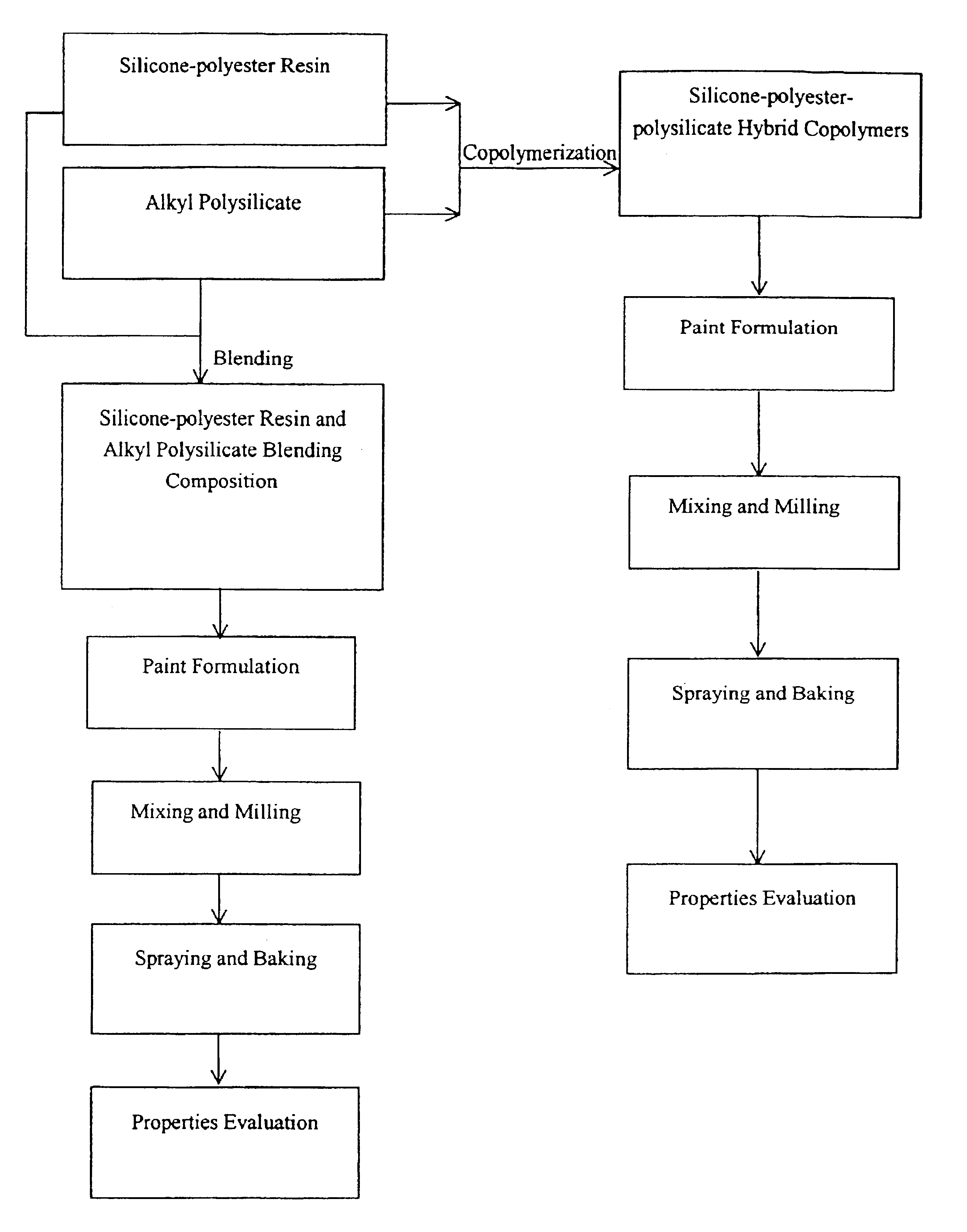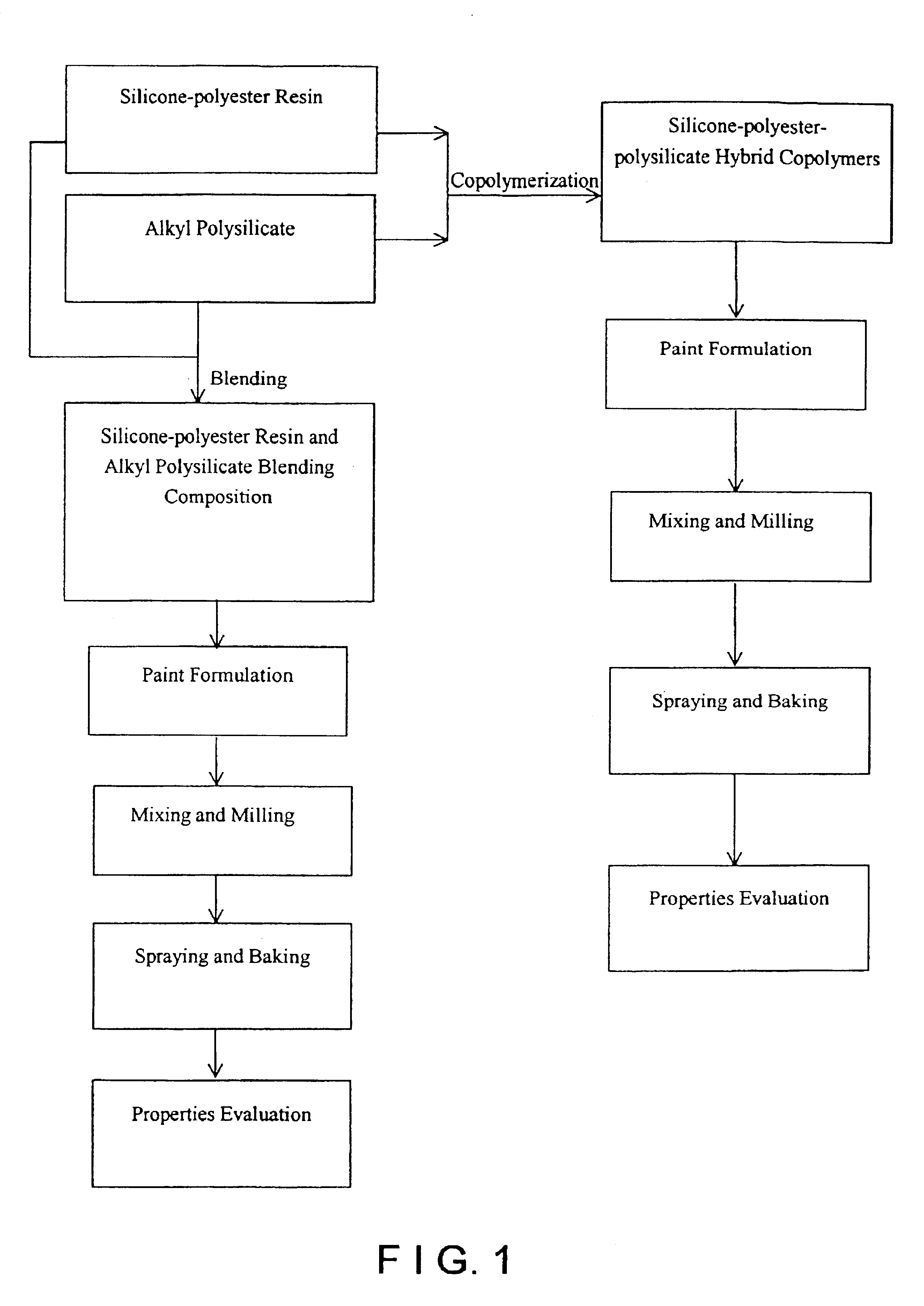Silicone-polyester-polysilicate hybrid compositions for thermal resistance coating
a technology of polysilicate and hybrid composition, which is applied in the direction of coating, transportation and packaging, chemical instruments and processes, etc., can solve the problems of unsatisfactory persistence of conventional silicone-polyester resin, increase the mechanical character of silicone, and increase the hardness and brittleness of silicone films, etc., to achieve good adhesion to metals and good thermal resistance
- Summary
- Abstract
- Description
- Claims
- Application Information
AI Technical Summary
Benefits of technology
Problems solved by technology
Method used
Image
Examples
example 1
[0021]TME (337 parts) and IPA (285 parts) are put into a 5 liters reactor for mixing, wherein the reactor equips a good heating system, a mechanical stirrer, and a N2 gas apparatus. After introducing N2 gas and heating the reactor to 160° C., xylene (12 parts) is added into the reactor. After retaining the temperature at 160° C. for 1 hour, the temperature is raised to 220° C. and retaining at 220° C. for about 4 hours. Then, some sample is taken for testing the acid value of the mixture in the reactor. When the acid value is less than 10 mgKOH / g, the heating process is stopped, and cooling the mixture to 120° C. Next, the solvent of PMA (propylene glycol monoethyl ether acetate, 140 parts) is added into the reactor and retaining the solid components at 80 wt. %. The polyester is heated to 100-120° C., and silicone resin Silres® SY 430 (790 parts), TBT (1.4 parts), and PMA (640 parts) are added. Under N2 surrounding, the reaction temperature is kept at 120° C.-130° C. for two hours,...
example 2
[0022]TME (337 parts) and IPA (285 parts) are put and mixed in a 5 liters reactor having a good heating system, a mechanical stirrer, and a N2 gas apparatus. After introducing N2 gas and raising the temperature to 160° C., xylene (12 parts) is added, and the temperature is kept at 160° C. for one hour. Then, the temperature is raised to 220° C. and retaining at 220° C. about 4 hours. Subsequently, the acid value is tested. The heating process is stopped and cooling to 120° C. when the acid value is less than 10 mgKOH / g. Next, the solvent of PMA (140 parts) is added, and keeping the solid component at 80 wt. %. The polyester is heated to 100-120° C. and, silicone resin Silres® REN 168 (790 part), TBT (1.4 parts), and PMA (640 parts) are added. Under N2 surrounding, the reaction temperature is kept at 120° C.-130° C. for two hours, and a transparent silicone-polyester resin solution can be obtained. Thereafter, the silicone-polyester resin solution is cooled down to 70° C., and the mi...
example 3
[0023]TME (285 parts), NPG (52 parts), and IPA (285 parts) are put and mixed in a 5 liters reactor having a good heating system, a mechanical stirrer, and a N2 gas apparatus. After introducing N2 gas and raising the temperature to 160° C., xylene (12 parts) is added, and the temperature is kept at 160° C. for one hour. Next, the temperature is raised to 220° C. The temperature is kept at 220° C. about 4 hours, and then the acid value of the mixture is tested. When the acid value is less than 10 mgKOH / g, the heating process is stopped and cooling the reaction to 120° C. Subsequently, the solvent of PMA (140 parts) is added and the solid component is kept at 80 wt. %. Then, the polyester is heated to 100-120° C., and silicone resin, Silres® REN 168 (790 part), TBT (1.4 parts), and PMA (640 parts) are added. Under N2 gas ambient, the reaction temperature is kept at 120° C.-130° C. for 2 hours, and then a transparent silicone-polyester resin solution can be obtained. After cooling down ...
PUM
| Property | Measurement | Unit |
|---|---|---|
| Temperature | aaaaa | aaaaa |
| Fraction | aaaaa | aaaaa |
| Percent by mass | aaaaa | aaaaa |
Abstract
Description
Claims
Application Information
 Login to View More
Login to View More - R&D
- Intellectual Property
- Life Sciences
- Materials
- Tech Scout
- Unparalleled Data Quality
- Higher Quality Content
- 60% Fewer Hallucinations
Browse by: Latest US Patents, China's latest patents, Technical Efficacy Thesaurus, Application Domain, Technology Topic, Popular Technical Reports.
© 2025 PatSnap. All rights reserved.Legal|Privacy policy|Modern Slavery Act Transparency Statement|Sitemap|About US| Contact US: help@patsnap.com


